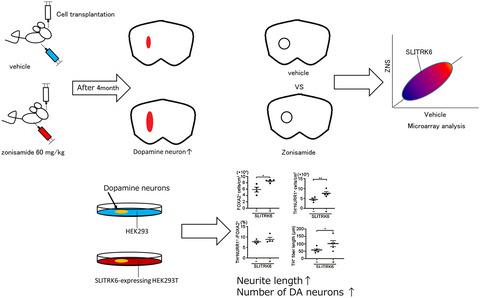当前位置:
X-MOL 学术
›
J. Neurosci. Res.
›
论文详情
Our official English website, www.x-mol.net, welcomes your
feedback! (Note: you will need to create a separate account there.)
Zonisamide promotes survival of human-induced pluripotent stem cell-derived dopaminergic neurons in the striatum of female rats.
Journal of Neuroscience Research ( IF 2.9 ) Pub Date : 2020-06-07 , DOI: 10.1002/jnr.24668 Yoshifumi Miyawaki 1 , Bumpei Samata 1 , Tetsuhiro Kikuchi 1 , Kaneyasu Nishimura 1 , Jun Takahashi 1
Journal of Neuroscience Research ( IF 2.9 ) Pub Date : 2020-06-07 , DOI: 10.1002/jnr.24668 Yoshifumi Miyawaki 1 , Bumpei Samata 1 , Tetsuhiro Kikuchi 1 , Kaneyasu Nishimura 1 , Jun Takahashi 1
Affiliation

|
The transplantation of dopaminergic (DA) progenitors derived from pluripotent stem cells improves the behavior of Parkinson's disease model animals. However, the survival of DA progenitors is low, and the final yield of DA neurons is only approximately 0.3%–2% the number of transplanted cells. Zonisamide (ZNS) increases the number of survived DA neurons upon the transplantation of mouse‐induced pluripotent stem (iPS) cell‐derived DA progenitors in the rat striatum. In this study, we induced DA progenitors from human iPS cells and transplanted them into the striatum of female rats with daily administration of ZNS. The number of survived DA neurons was evaluated 1 and 4 months after transplantation by immunohistochemistry, which revealed that the number of survived DA neurons was significantly increased with the administration of ZNS. To assess the mechanism of action of ZNS, we performed a gene expression analysis to compare the gene expression profiles in striatum treated with or without ZNS. The analysis revealed that the expression of SLIT‐and NTRK‐like protein 6 (SLITRK6) was upregulated in rat striatum treated with ZNS. In conclusion, ZNS promotes the survival of DA neurons after the transplantation of human‐iPS cell‐derived DA progenitors in the rat striatum. SLITRK6 is suggested to be involved in this supportive effect of ZNS by modulating the environment of the host brain.
中文翻译:

唑尼沙胺促进雌性大鼠纹状体中人类诱导的多能干细胞衍生的多巴胺能神经元的存活。
来自多能干细胞的多巴胺能 (DA) 祖细胞的移植改善了帕金森病模型动物的行为。然而,DA 祖细胞的存活率较低,最终 DA 神经元的产量仅为移植细胞数量的 0.3%–2%。在大鼠纹状体中移植小鼠诱导的多能干 (iPS) 细胞衍生的 DA 祖细胞后,唑尼沙胺 (ZNS) 增加了存活的 DA 神经元的数量。在这项研究中,我们从人类 iPS 细胞中诱导 DA 祖细胞,并将它们移植到雌性大鼠的纹状体中,每天服用 ZNS。移植后 1 个月和 4 个月,通过免疫组织化学评估存活的 DA 神经元数量,结果表明,施用 ZNS 后存活的 DA 神经元数量显着增加。为了评估 ZNS 的作用机制,我们进行了基因表达分析,以比较用或不用 ZNS 处理的纹状体中的基因表达谱。分析表明,在用 ZNS 处理的大鼠纹状体中,SLIT 和 NTRK 样蛋白 6(SLITRK6)的表达上调。总之,在将人 iPS 细胞衍生的 DA 祖细胞移植到大鼠纹状体中后,ZNS 促进了 DA 神经元的存活。建议 SLITRK6 通过调节宿主大脑的环境参与 ZNS 的这种支持作用。在将人 iPS 细胞衍生的 DA 祖细胞移植到大鼠纹状体中后,ZNS 促进 DA 神经元的存活。建议 SLITRK6 通过调节宿主大脑的环境参与 ZNS 的这种支持作用。在将人 iPS 细胞衍生的 DA 祖细胞移植到大鼠纹状体中后,ZNS 促进 DA 神经元的存活。建议 SLITRK6 通过调节宿主大脑的环境参与 ZNS 的这种支持作用。
更新日期:2020-06-25
中文翻译:

唑尼沙胺促进雌性大鼠纹状体中人类诱导的多能干细胞衍生的多巴胺能神经元的存活。
来自多能干细胞的多巴胺能 (DA) 祖细胞的移植改善了帕金森病模型动物的行为。然而,DA 祖细胞的存活率较低,最终 DA 神经元的产量仅为移植细胞数量的 0.3%–2%。在大鼠纹状体中移植小鼠诱导的多能干 (iPS) 细胞衍生的 DA 祖细胞后,唑尼沙胺 (ZNS) 增加了存活的 DA 神经元的数量。在这项研究中,我们从人类 iPS 细胞中诱导 DA 祖细胞,并将它们移植到雌性大鼠的纹状体中,每天服用 ZNS。移植后 1 个月和 4 个月,通过免疫组织化学评估存活的 DA 神经元数量,结果表明,施用 ZNS 后存活的 DA 神经元数量显着增加。为了评估 ZNS 的作用机制,我们进行了基因表达分析,以比较用或不用 ZNS 处理的纹状体中的基因表达谱。分析表明,在用 ZNS 处理的大鼠纹状体中,SLIT 和 NTRK 样蛋白 6(SLITRK6)的表达上调。总之,在将人 iPS 细胞衍生的 DA 祖细胞移植到大鼠纹状体中后,ZNS 促进了 DA 神经元的存活。建议 SLITRK6 通过调节宿主大脑的环境参与 ZNS 的这种支持作用。在将人 iPS 细胞衍生的 DA 祖细胞移植到大鼠纹状体中后,ZNS 促进 DA 神经元的存活。建议 SLITRK6 通过调节宿主大脑的环境参与 ZNS 的这种支持作用。在将人 iPS 细胞衍生的 DA 祖细胞移植到大鼠纹状体中后,ZNS 促进 DA 神经元的存活。建议 SLITRK6 通过调节宿主大脑的环境参与 ZNS 的这种支持作用。











































 京公网安备 11010802027423号
京公网安备 11010802027423号